Mike Phillips
Active member
- Dec 5, 2022
- 51,004
- 6
Review: Autogeek ProLock Power Cord by Mike Phillips
Autogeek ProLock Power Cord

What it is?
Professional grade, correct gauge wire, extension cord.
What it does?
Fully passes the 110 volt current from the power source to the power tool without any drop in Amperage, Wattage or Voltage.
When to use it?
Anytime you cannot plug your power tool directly into an electrical outlet.
Why to use it?
To prevent damage to your power tool's electric motor and components.
Special Instructions
While you can FORCE the electric prongs of the male end of a power cord into the ProLock receptacle, it's better over the life of the tool to pull back on the locking color and take the tension off the locking mechanism first.
From the manufacturer
• Manufactured to 12/3 AWG (American Wire Gauge) specifications.
• Each of the three conductors contain 65 strands of 30 AWG 100% copper wire.
• Automatic locking feature: Simply insert U-Ground plug into our patented Pro Lock® connector, and push together to lock. Pull the collar back to unlock. It's that simple.
• Our Pro Lock® connectors are manufactured with high impact polycarbonate on both housing & collar. They provide hard service use and will not shatter.
• Pro Lock® Pull Resistance: 80 Lbs. horizontally or vertically.
• Molded Lighted Amber Power Check plug and indicates there is power running through the cord.
• Molded Pro Lock® green lighted CGM connector identifies the cord has ground continuity.
• Our -58°F (-50°C) special cold weather PVC jacket guarantees working flexibility in temperatures well below freezing.
• UL Listed and cUL for Canada.
Continuous Ground Monitoring or CGM
When plugged into a grounded electrical outlet, the receptacle end of the cord will emit a glowing green light. When you see this you know your cord is plugged into a properly functioning grounded electrical outlet.
My comments...
A while back, I met a gentlemen by the name of Michael Vern via Facebook. Michael was restoring the original paint on a 1970 Ford Ranger Truck for a good friend of the family. His friend's dad bought this truck new from the dealership and it's going to remain in the family. Michael found me by researching information on how-to restore original single stage paint where he found my original article on the topic, this one,
The Secret to Removing Oxidation and Restoring a Show Car Finish to Antique Single Stage Paints
Later he contacted me with a few questions on the technique I shared in the above article. As a part of writing this review, I contacted Michael and asked him if it was okay to share his behind-the-scenes story and if so, could I get a couple of pictures of the truck to which he used the Meguiar's #7 I share in the above article. Michael was more than happy to help out and sent me the before and after pictures you see below.
Here's the truck before,

Here's the truck after,

Nice work buddy! :dblthumb2:
Fast-forward
About a year later and I get a call from Michael about a new product. Michael knew I detail cars and also teach car detailing classes and he wanted to share a quality extension cord from the company he started working for MilSpec Industries.
Just by coincidence, I had submitted a budget request for new extension cords for the car and boat detailing classes I teach here at Autogeek. Our last set of cords were now about 5 years old and the female receptacles were so worn out that tools would no longer stay plugged-in. They were so worn out that If found myself instructing the students in all my classes on how to TAPE the cords together.
Taping cords together
I always have 3M green painter's tape on hand in my classes so I would simply request everyone to use a strip of tape to tape their cords together like this,

While not a perfect solution, it's better than tying knots with the cord ends because it creates less of a trip hazard.

Don't tie cords
Before the ProLock Power Cords, I would specifically asked my students to tape their cord ends together because if I didn't bring this topic up, then what normally happens is the students TIE their cords together in one of the 2 different methods below.
Here's one way people tie cords together to make sure they don't come unplugged.
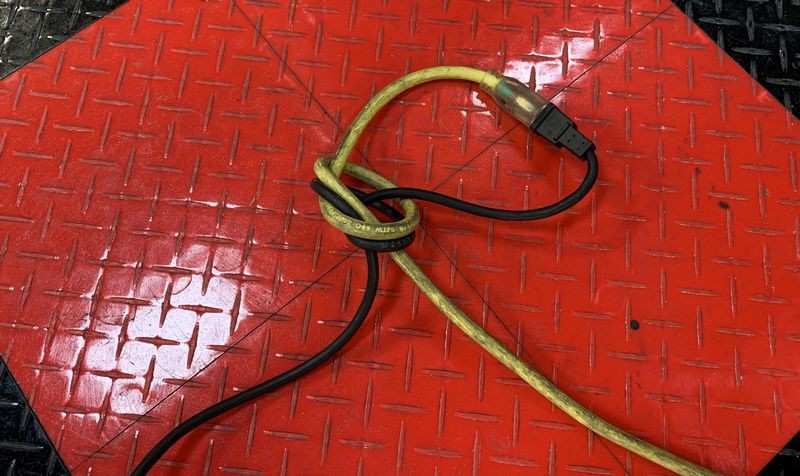
Here's the other common way people tie cords together to make sure they don't come unplugged.
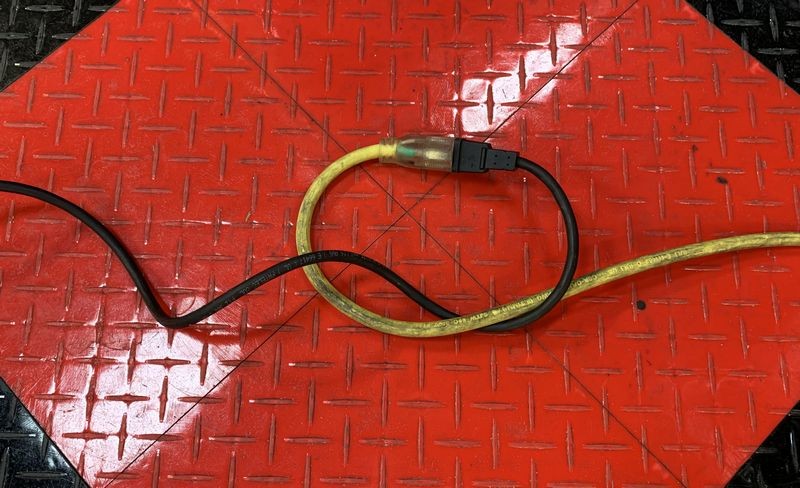
Both methods of tying cords together create a trip hazard so neither are workable solutions.
When I have 15 to 25 people in a class, that's a LOT of extension cords on the floor for me to have to navigate around. If you look at the floor areas in these two pictures, you can see the old yellow extension cords on the ground. It can get a little messy to walk around...
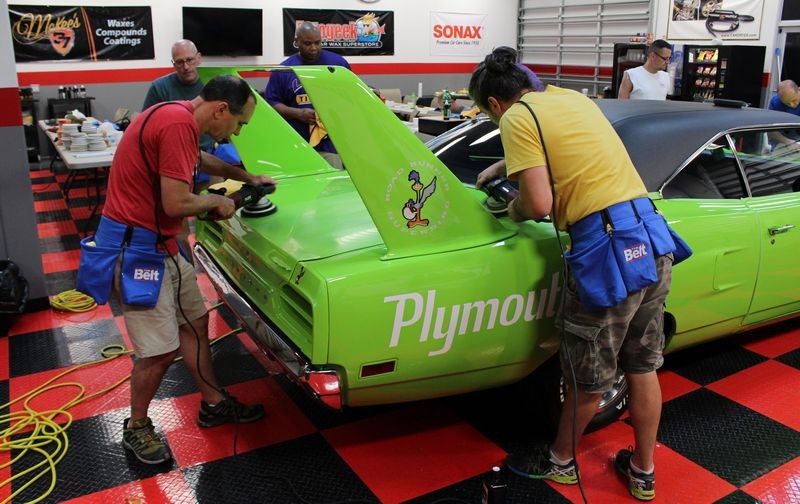
Here's a better shot of what a lot of cords look like on the floor at one of my boat detailing classes.
When people tie their cords together, it makes a trip hazard for Mike Phillips, (that's me), and I don't want to trip and I certainly don't have time to fall and possibly break one of my legs during a class. Plus, when people tie the end of their cords together, it causes me to talk in third person.

Here's the solution!
The Autogeek ProLock Power Cord!

While the locking mechanism is cool, let's talk about the built-in SAFETY feature first.
Continuous Ground Monitoring or CGM
When plugged into a grounded electrical outlet, the receptacle end of the cord will emit a glowing green light. When you see this you know your cord is plugged into a properly functioning grounded electrical outlet.
In the above sentence, I made the word grounded to show up as red text. That's because that's the key to working safely. Anytime you're using power tools, for the safety of the tool and the safety of yourself, you should be using AC current that includes a ground wire. When your ProLock Power Cord is plugged into a true GROUNDED electrical outlet there's a GREEN EMERALD light that lights up BRIGHT in the center of the female receptacle. If your ProLock Power Cord is NOT plugged into a truly grounded electrical outlet, the light is dim, hard to see.
To show this safety feature, I took a cheap extension cord and cut away the plastic that prevents the male end of a power cord from being plugged in the wrong way. I did this on purpose to show via the below pictures the difference in the brightness of the emerald green light when plugged into a grounded outlet versus a non-grounded outlet.
Note the YELLOW box I place around the plug-in. In the first picture, the ProLock cord is plugged in correctly and is grounded. In the second picture, the ProLock cord is plugged in incorrectly and is not grounded.
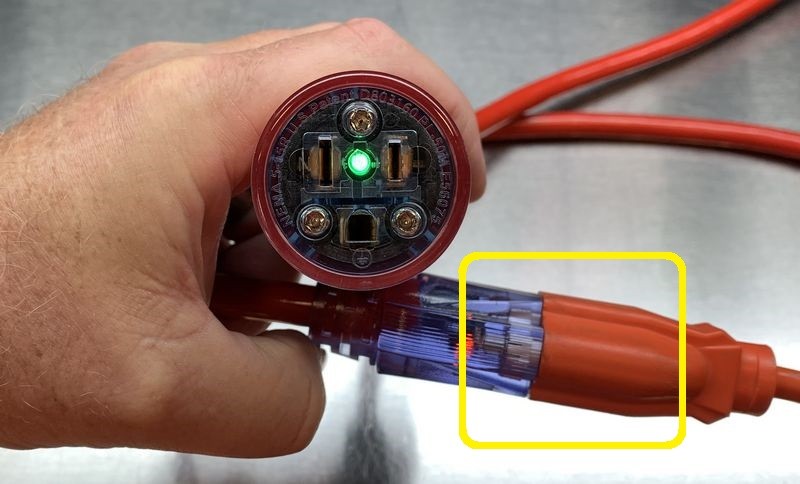
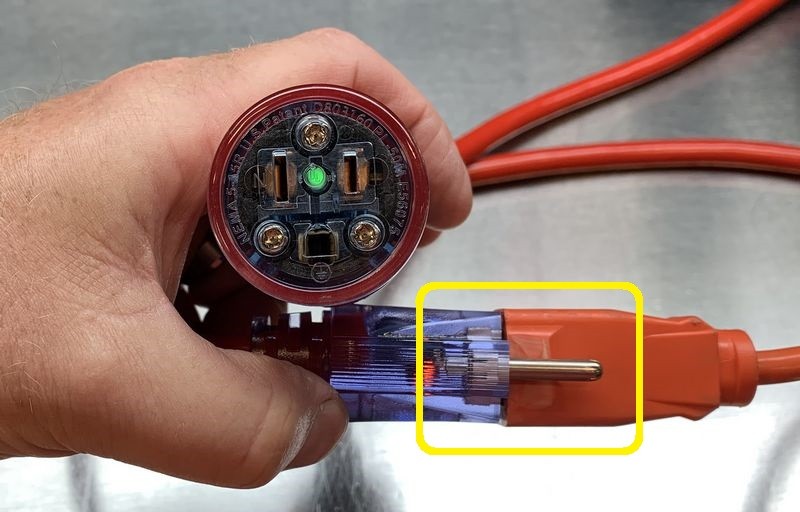
Here's close-ups showing the difference between the bright emerald green light versus the dim green light.


So make sure the emerald green light is BRIGHT before plugging in any of your power tools. Even if you are plugged into an electrical outlet that has the ground slot, that doesn't mean the electrical outlet is actually wired to code. It could also be a sign of a wiring problem behind the wall.

How the connector works
To use the ProLock Power Cord, using your fingers, pull back on the spring-loaded connector.

The sliding connector pulls back about 3/8" of an inch.

Now insert the male end of the power cord for your tool. Yes - you can simply shove the prongs into the slots without pulling the sliding connector back first, but by sliding the connector back first you remove all the tension on the internal wear parts.

After pressing the prongs into the slots, release the sliding connector.

Here's the sliding connector pulled back....
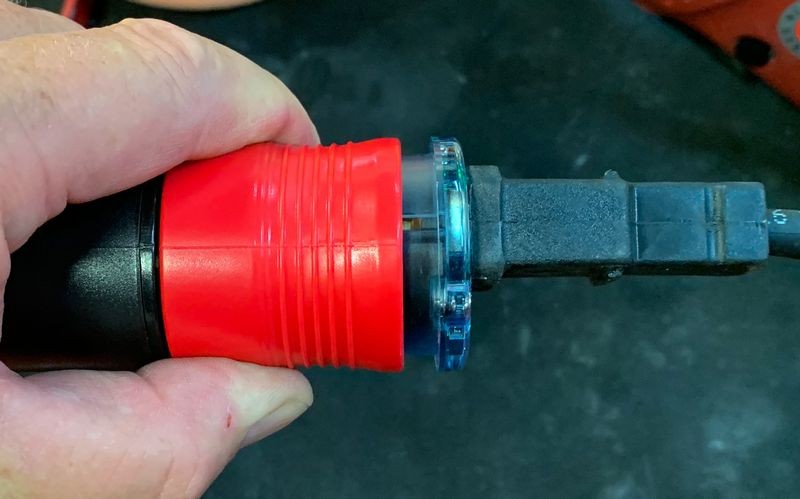
Here's the sliding connector released to the LOCKED POSITION
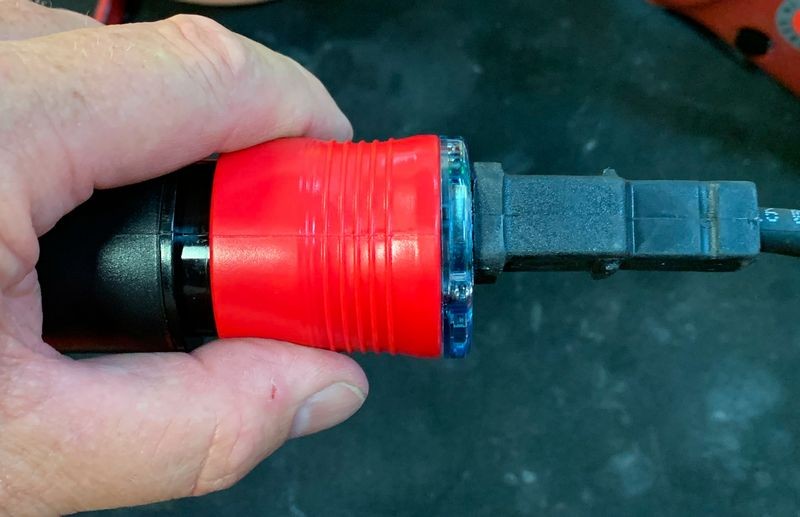
The connection is strong and secure.

The Autogeek ProLock Power Cord is 25 feet long, more than enough for detailing your car in your garage.



Review
I love these cords. I don't have time to be messing around with my cords coming unplugged. I also don't like to waste my time or painter's tape - taping the end of my power tool to the end of an extension cord. I'm also too smart to use cheap, small gauge extension cords as this leads to an under performing tool and eventually tool failure.
The first time I used a ProLock extension cord I was impressed with the solid locking design and I took comfort knowing my tools are getting all the power they need and deserve to operate at max performance.
If you value your tool investment, then get an Autogeek ProLock Power Cord and never look back. I guarantee you'll never regret this investment. I think so highly of them, Autogeek let me purchase 20 of them and they are the official power cord for all our detailing classes.
On Autogeek.com
Autogeek ProLock Power Cord

Autogeek ProLock Power Cord
What it is?
Professional grade, correct gauge wire, extension cord.
What it does?
Fully passes the 110 volt current from the power source to the power tool without any drop in Amperage, Wattage or Voltage.
When to use it?
Anytime you cannot plug your power tool directly into an electrical outlet.
Why to use it?
To prevent damage to your power tool's electric motor and components.
Special Instructions
While you can FORCE the electric prongs of the male end of a power cord into the ProLock receptacle, it's better over the life of the tool to pull back on the locking color and take the tension off the locking mechanism first.
From the manufacturer
• Manufactured to 12/3 AWG (American Wire Gauge) specifications.
• Each of the three conductors contain 65 strands of 30 AWG 100% copper wire.
• Automatic locking feature: Simply insert U-Ground plug into our patented Pro Lock® connector, and push together to lock. Pull the collar back to unlock. It's that simple.
• Our Pro Lock® connectors are manufactured with high impact polycarbonate on both housing & collar. They provide hard service use and will not shatter.
• Pro Lock® Pull Resistance: 80 Lbs. horizontally or vertically.
• Molded Lighted Amber Power Check plug and indicates there is power running through the cord.
• Molded Pro Lock® green lighted CGM connector identifies the cord has ground continuity.
• Our -58°F (-50°C) special cold weather PVC jacket guarantees working flexibility in temperatures well below freezing.
• UL Listed and cUL for Canada.
Continuous Ground Monitoring or CGM
When plugged into a grounded electrical outlet, the receptacle end of the cord will emit a glowing green light. When you see this you know your cord is plugged into a properly functioning grounded electrical outlet.
My comments...
A while back, I met a gentlemen by the name of Michael Vern via Facebook. Michael was restoring the original paint on a 1970 Ford Ranger Truck for a good friend of the family. His friend's dad bought this truck new from the dealership and it's going to remain in the family. Michael found me by researching information on how-to restore original single stage paint where he found my original article on the topic, this one,
The Secret to Removing Oxidation and Restoring a Show Car Finish to Antique Single Stage Paints
Later he contacted me with a few questions on the technique I shared in the above article. As a part of writing this review, I contacted Michael and asked him if it was okay to share his behind-the-scenes story and if so, could I get a couple of pictures of the truck to which he used the Meguiar's #7 I share in the above article. Michael was more than happy to help out and sent me the before and after pictures you see below.
Here's the truck before,
Here's the truck after,
Nice work buddy! :dblthumb2:
Fast-forward
About a year later and I get a call from Michael about a new product. Michael knew I detail cars and also teach car detailing classes and he wanted to share a quality extension cord from the company he started working for MilSpec Industries.
Just by coincidence, I had submitted a budget request for new extension cords for the car and boat detailing classes I teach here at Autogeek. Our last set of cords were now about 5 years old and the female receptacles were so worn out that tools would no longer stay plugged-in. They were so worn out that If found myself instructing the students in all my classes on how to TAPE the cords together.
Taping cords together
I always have 3M green painter's tape on hand in my classes so I would simply request everyone to use a strip of tape to tape their cords together like this,
While not a perfect solution, it's better than tying knots with the cord ends because it creates less of a trip hazard.
Don't tie cords
Before the ProLock Power Cords, I would specifically asked my students to tape their cord ends together because if I didn't bring this topic up, then what normally happens is the students TIE their cords together in one of the 2 different methods below.
Here's one way people tie cords together to make sure they don't come unplugged.
Here's the other common way people tie cords together to make sure they don't come unplugged.
Both methods of tying cords together create a trip hazard so neither are workable solutions.
When I have 15 to 25 people in a class, that's a LOT of extension cords on the floor for me to have to navigate around. If you look at the floor areas in these two pictures, you can see the old yellow extension cords on the ground. It can get a little messy to walk around...
Here's a better shot of what a lot of cords look like on the floor at one of my boat detailing classes.
When people tie their cords together, it makes a trip hazard for Mike Phillips, (that's me), and I don't want to trip and I certainly don't have time to fall and possibly break one of my legs during a class. Plus, when people tie the end of their cords together, it causes me to talk in third person.

Here's the solution!
The Autogeek ProLock Power Cord!
While the locking mechanism is cool, let's talk about the built-in SAFETY feature first.
Continuous Ground Monitoring or CGM
When plugged into a grounded electrical outlet, the receptacle end of the cord will emit a glowing green light. When you see this you know your cord is plugged into a properly functioning grounded electrical outlet.
In the above sentence, I made the word grounded to show up as red text. That's because that's the key to working safely. Anytime you're using power tools, for the safety of the tool and the safety of yourself, you should be using AC current that includes a ground wire. When your ProLock Power Cord is plugged into a true GROUNDED electrical outlet there's a GREEN EMERALD light that lights up BRIGHT in the center of the female receptacle. If your ProLock Power Cord is NOT plugged into a truly grounded electrical outlet, the light is dim, hard to see.
To show this safety feature, I took a cheap extension cord and cut away the plastic that prevents the male end of a power cord from being plugged in the wrong way. I did this on purpose to show via the below pictures the difference in the brightness of the emerald green light when plugged into a grounded outlet versus a non-grounded outlet.
Note the YELLOW box I place around the plug-in. In the first picture, the ProLock cord is plugged in correctly and is grounded. In the second picture, the ProLock cord is plugged in incorrectly and is not grounded.
Here's close-ups showing the difference between the bright emerald green light versus the dim green light.
So make sure the emerald green light is BRIGHT before plugging in any of your power tools. Even if you are plugged into an electrical outlet that has the ground slot, that doesn't mean the electrical outlet is actually wired to code. It could also be a sign of a wiring problem behind the wall.
How the connector works
To use the ProLock Power Cord, using your fingers, pull back on the spring-loaded connector.
The sliding connector pulls back about 3/8" of an inch.
Now insert the male end of the power cord for your tool. Yes - you can simply shove the prongs into the slots without pulling the sliding connector back first, but by sliding the connector back first you remove all the tension on the internal wear parts.
After pressing the prongs into the slots, release the sliding connector.
Here's the sliding connector pulled back....
Here's the sliding connector released to the LOCKED POSITION
The connection is strong and secure.
The Autogeek ProLock Power Cord is 25 feet long, more than enough for detailing your car in your garage.
Review
I love these cords. I don't have time to be messing around with my cords coming unplugged. I also don't like to waste my time or painter's tape - taping the end of my power tool to the end of an extension cord. I'm also too smart to use cheap, small gauge extension cords as this leads to an under performing tool and eventually tool failure.
The first time I used a ProLock extension cord I was impressed with the solid locking design and I took comfort knowing my tools are getting all the power they need and deserve to operate at max performance.
If you value your tool investment, then get an Autogeek ProLock Power Cord and never look back. I guarantee you'll never regret this investment. I think so highly of them, Autogeek let me purchase 20 of them and they are the official power cord for all our detailing classes.
On Autogeek.com
Autogeek ProLock Power Cord